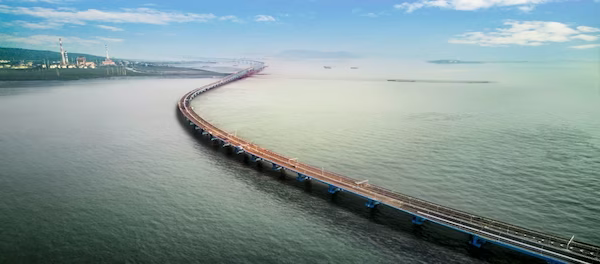Atal Setu the Mumbai Trans Harbour Link was inaugurated by the Prime Minister of India on Friday. Mumbai Trans Harbour Link is the country’s longest sea bridge.
The travel time between South Mumbai and Navi Mumbai is expected to reduce from 2 hours to just 20 minutes.
The 22-kilometer-long bridge is built approximately for Rs 17,840 crore and stands as an attestation to Indian engineering brilliance.
According to the press release from the office of the Chief Minister of Maharashtra, the amount of steel used for its construction is equal to the weight of 500 Boeing Aeroplanes and 17 times that of the Eiffel Tower’s weight.
The six-lane-long Mumbai Trans Harbour Sea Link connects Sewri on the island city to Nhava-Sheva on the mainland which also includes a 16.5 km long sea link.
504,253 metric tonnes of cement and 177,903 metric tonnes of steel are used to build India’s longest sea bridge. For Navi Mumbai currently, there are two access points one from the Airoli-Mulund connector and the second is the Vashi connector.
As Mumbai’s traffic is known as the busiest traffic, the new Mumbai Trans Harbour Link will reduce travel time between Mumbai and Navi Mumbai which will also lead to the regional integration of neighbouring Raigad district into Mumbai’s ecosystem.
Traffic Projections, Average Travel Time, Cost, Fuel Savings
The new Mumbai Trans Harbour Link is expected to see 39,900 vehicles daily between Sewri and Shivaji Nagar interchange, while 9,800 vehicles will hasten between the Shivaji Nagar and Chirle interchange.
The longest bridge will reduce the travel distance from south Mumbai to Chirle to around 30 km and it will take around 16 minutes to cross the bridge which will save at least 1 hour of travel time.
The longest bridge is designed in such a way that it can carry 70,000 vehicles per day and have a life of 100 years.
Single car journey will need to pay Rs 250 toll tax one way, the Daily pass costs Rs 650 and the Monthly pass around Rs 12,500.
It is said that one crore liters of fuel is expected to be saved per year by commuting this bridge.
10 Key Things To Know about this Engineering Landmark:
- The Atal Setu is built according to passenger safety which has specially designed lighting polls to withstand high-velocity winds during monsoon, furnished with a Lightning Protection System to protect against damage caused by lightning.
- Crash barriers with an overall height of 1,550 mm which meets international standards are installed for the safety of travellers.
- As the portion of the bridge passes through a pink bird-protected area and highly sensitive area Bhabha Atomic Research Centre an 8.5 km noise barrier and a 6km of view barrier from Sewri have been installed to protect sensitive stretches.
- According to MMRDA documents, an average of 5,403 workers and engineers were involved every day in the completion of the project since 2018.
- According to the information received through an RTI query by activist Anil Galgali Atal Setu saw a cost escalation of Rs. 2,192 crore. The total cost of the project increased by 2,200 crore owing to delays due to Covid lockdowns. Original cost Rs. 14,712.70 crore and surges to Rs. 16,904.43 crore.
- Atal Setu integrates 254 seismic isolation bearings, acting as a buffer between the bridge and bridge deck and the supporting docks so during earthquakes these bearings allow the deck to move independently, absorbing quiver and protecting the structure during earthquake resistance.
- The peak-performance concrete blend used in the bridge of construction withstands the caustic onslaught of seawater and the relentless of Mumbai sun. Its low heat generation minimizes cracking and ensures long-lasting sturdiness.
- One of the toughest tasks in constructing this giant bridge was building it underwater.
- Advanced equipment like remote-operated vehicles and Skilled divers were used in constructing the bridge’s pylons and foundations.
- The notion of a connector linking the Island City of Mumbai to the mainland was first recommended in 1962 in a study titled “Planning of Road System for Mumbai Metropolitan Region “
pic credit: CNBC

